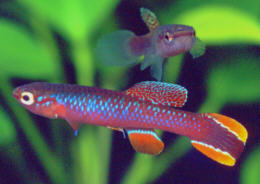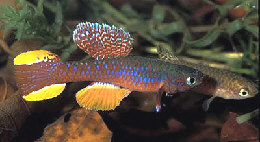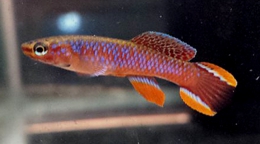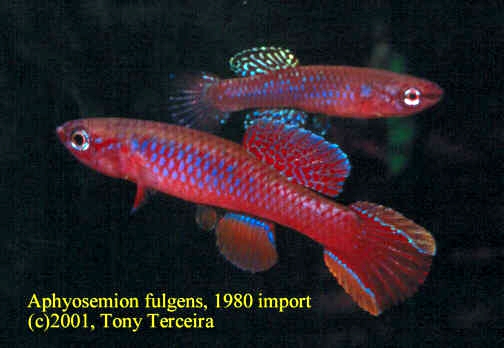| Meaning
of Name |
fulgens,
meaning brilliant or splendid. |
| First
Description |
Radda
1975. Contribution to the knowledge of the
Cyprinodonts of Gabon, with the description of four new species and one new subspecies
of the genus Aphyosemion Myers. Killi-News
118 (Seperate): 18-19, figure. (BKA). |
| Size |
35.5 mm (Radda 1975) |
| Meristics |
D = 12-13, A = 11-13, D/A = 4/1 (-4), ll = 26-27. |
| Karyotype |
n = 19, A = 19 (Scheel 1981, 1990) |
| Sub-Genus |
Diapteron |
| Group |
|
| Synonyms |
- Aphyosemion georgiae
nov. s.spec.;Böhm 1973
- Aphyosemion
georgiae fulgens Radda 1975
- Aphyosemion
fulgens Huber 1977
- Aphyosemion
(Diapteron) fulgens
Huber 1980
- Diapteron
fulgens Seegers 1980
|
Populations
- Makokou (west)(northern Gabon).
- Ovan
- ABDEK 2012 / 482 -
South Makokou
- LEC 93/6
- LEC 93/7
|
|

30 km west of Makokou.
Photo courtesy of Ed Pürzl.
|

LEC 93 / 6
Photo courtesy of Gunther Schmaus.
|
|
LEC 93 / 7 - Collected
January 9th 1993 at 4.00 pm in the Béniaré stream between
the villages of Ebandak & Ebegna on the road to Ovan at 48·5
kms from the end of the asphalted road in Makokou. Stream was 100-150
cms wide with a maximum depth of 40 cms. Water temperature 24°C,
pH 6·3, 0dGH. Sympatric species include A.sp.aff.cameronense
Phenotype 7, A.splendidum, A.punctatum, E.neumanni,
Barbus sp. Characidae,
Mastacembelus & shrimps.
|

LEC 93 / 7
Photo courtesy of Jeff Wasley.
|
|
| Type
Locality |
Close
to Esenkelle, 52 km to the west of Makokou. |
| Distribution |
The Ivindo River drainage of northern Gabon. |
| Habitat |
Rainforest brooks & swampy rainforest areas. |
| Distinguishing
Characteristics |
|
| Colour/Pattern
Variability |
|
| History |
On first introduction to Germany this sp. proved difficult
to breed & it took a few years to establish a breeding colony. During this
period they were on the edge of extinction in captivity. Prices in Germany for
this sp. were noted as being very high. |
| Breeding
Notes |
Not
an easy species to breed. The use of peat fibre is reported to be useful in breeding
them. This can be taken out after a period of 10-14 days & put into a seperate
container for hatching.
Newly hatched fry are
small & do best on infusorians or Paramacium as a starter food.
Growth
is reportedly slow & it can take 8 months to reach sexual maturity.
John
Buytaert considered the secret to breeding this sp. was to keep them cool &
add salt to the water. Brian Horsfall in BKA
Newsletter N0.271 (March 1988) observed the following:
dKH should be zero,
General hardness should be 0·5 (conductivity no higher than 100 microsiemens,
preferably less). pH should be at least 6 although prolonged exposure to 3·8
did them no harm.
Large tanks should be used for breeding with lots of variety
in live foods offered. Prepared food should not be offered to this sp.
Use
only one male in the breeding set up. Generally it was felt that seperate conditioning
was a waste of time.
A female is capable of producing 10 eggs per week. No
cannibalism towards eggs was observed by from the parents. However, females will
predate fry.
Eggs incubated at what he considered the optimum temperature of
20-21°C at night & 24°C during the day. An incubation period of 15-21
days was observed. This was noted to be longer than other Diapteron
sp.(cyanostictum, abacinum,
georgiae. seegersi
was was maintained at this time).
At higher temperatures (26-27°C )eggs
were noted as developing faster - in 7-9 days, but fry did not straighten out
or become free swimming. They 'flopped about the dish, looking like drunken commas'.
These fry lasted only a day or two before they died.
At lower temperatures
(16-17°C) incubation was much slower. After 4 weeks of incubation eggs rarely
hatched until a normal temperature was restored. Fry on hatching then had large
yolk sacs & were observed to be shorter & stumpier than normal. These
frequently died without becoming free swimming.
Fresh water was observed to
be a good addition to the egg container to induce hatching.
Young fish of cyanostictum,
fulgens & georgiae
were observed to be half grown & fully sexable at 8-10 weeks of age. |
| Diameter
of Egg |
|
| Remarks |
|
